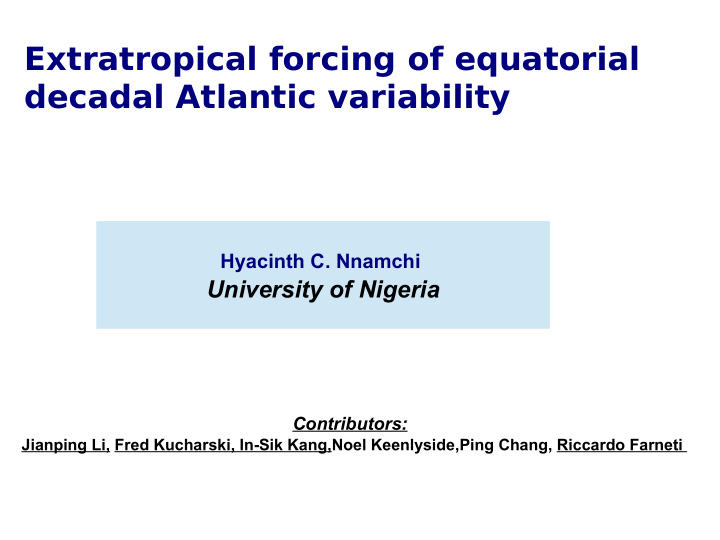



Extratropical forcing of equatorial decadal Atlantic variability Hyacinth C. Nnamchi University of Nigeria Contributors: Jianping Li, Fred Kucharski, In-Sik Kang,Noel Keenlyside,Ping Chang, Riccardo Farneti
Tropical Atlantic Variability (TAV) in different seasons 1. Boreal spring (MAM) Atlantic meridional mode (AMM) 2. Summer (JJA) Atlantic Niño, similar to the Pacifjc El Niño
Time scales of TAV in MAM & JJA. Atlantic meridional mode: sub-decadal; ~8 years. Atlantic zonal mode: interannual; 1.6-4.5 years.
Mechanisms of Atlantic Niño: All based ocean dynamics. Mechanisms of Atlantic Niño Bjerknes feedback: wind – SST - thermocline feedback. New Atlantic Niño: driven by mixed layer temperature advection from north tropical Atlantic Ocean (Richter et al., 2013, Nature Geosci) . Equatorial Atlantic Kelvin waves: deep zonal jets oscillate at 4.5yrs causing Atlantic Nino SST anomalies. Similar jets in Indian and Pacifjc oceans do not interannual time scales (Brandt et al., 2011, Nature) .
How essential is ocean dynamics for Atlantic Niño? Nnamchi et al., (2015), Thermodynamic controls of the Atlantic Niño. Nature Communications . 6 , doi: 10.1038/ncomms9895.
How essential is ocean dynamics for Atlantic Niño? Nnamchi et al., (2015), Thermodynamic controls of the Atlantic Niño. Nature Communications . 6 , doi: 10.1038/ncomms9895. ∂t =− [ u ∂T ∂ x ] − [ v ∂T ∂ y ] − [ w ∂T ∂ z ] + Q SW −Q LW −Q LH −Q SH ∂ [ T ] + R ρC w h ρ, sea water density; Cp, specific heat constant pressure; h, ocean mixed layer depth; Qnet, net radiation; R, unresolved physical processes. Q net ∂T = + Q flux Slab model equation: ρ hC w ∂t Qflux, climatological-mean ocean heat flux. h = 50 m.
MIROC3.2 (medres) GFDL-CM2.0 Nnamchi et al., (2015), Nature Commun .
Proportions of observed variability explained by “slab” processes. Nnamchi et al., (2015), Nature Commun . Observation
Equatorial Atlantic ocean mixed layer depth Mixed layer of models not shallower than the observed
Equatorial Atlantic ocean mixed layer depth
“Slab” as a predictor of total variability Nnamchi et al., (2015), Nature Commun .
Atmosphere's role in equatorial Atlantic variability?
Atmosphere's role in equatorial Atlantic variability? ~8 years
Atmosphere's role in equatorial Atlantic variability? ~8 years Garcia-Serrano et al., 2013 .
Observations Contours show significant decadal variability in spring to summer months.
Spatial patterns of TAV in spring and summer Correlations with regional precipitation anomalies. G. Sahel NS Coast America 20CR 0.60* -0.36 0.56* Obs 0.45* -0.11 0.50*
“Pan-Atlantic mode” Xie and Tanimoto (1998)
Evolution of tropical Atlantic decadal variability March-April: meridional mode. May June: Transition. July-August: zonal mode.
Evolution of tropical Atlantic decadal variability March-April: meridional mode. May June: Transition. July-August: zonal mode.
TAV transition in JJA May-June transition Strongest variability, but also transition occur in May June.
TAV transition in JJA Coupled variability, “Pan-Atlantic mode” Maximum Covariance Analysis (MCA): SST and SLP
Concluding remarks *Robust decadal variability occur in equatorial Atlantic in JJA. *Related to precipitation over the nearby continents. *May be seen as a part of “Pan Atlantic mode”, with extratropical to tropical connections.
Deser et al., 2010, GRL 1st EOF of global JJA SST Blue line: SA Ocean [5N-45S, 60W-20E] Mean SST anomaly. ∆ is the regression between x (global) and y (BW) anomaly r is the correlation SST ' filtered = SST ' raw − BWA low. freq
Recommend
More recommend